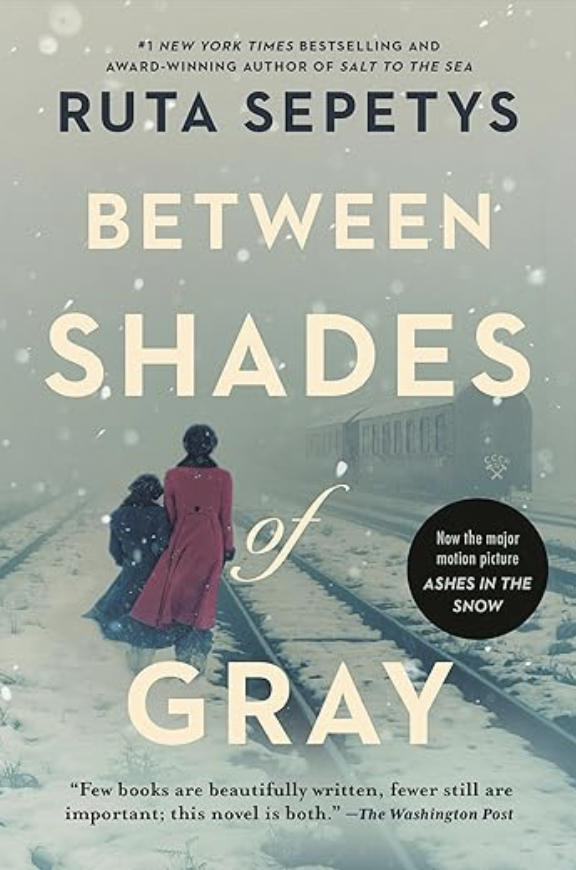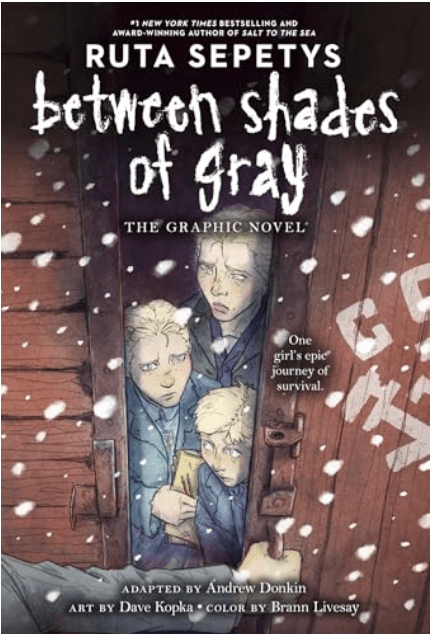
Between Shades of Gray by Ruta Sepetys is a startlingly blunt tale that showcases the bravery, but also hardships, of the Lithuanian people who were arrested by the Soviet Secret Police — the NKVD — during WWII. Those seen as ‘anti-Soviet’ were targeted, typically those who were educated or of a high status, and were deported to Siberia to work in inhumane conditions. Although the characters in Sepetys’s novel are fiction, the history is based on true events with specific details provided by people that Sepetys spoke to during two trips to Lithuania for research.
The story follows Lina, a strong-willed 15-year-old girl who gets taken from her home in the middle of the night with her younger brother Jonas and mother Elena. Separated from their father who never returned home from work the night before, Lina and her family spend the next year motivated with the hope of being reunited with him as they are moved from camp to camp. As they spend weeks on trains meant for cattle before arriving at a beet farm, they meet a courageous boy Lina’s age named Andius, a young girl named Janina, and an entire cast of characters that stay with the Vilkas’s throughout their journey to Siberia.
Art in the form of drawings is an important concept throughout the book as Lina passes along secret drawings in the hopes that they will reach her father. Drawing is how she lets out her emotions, and conveys her pain when she is unable to speak. Strokes and sketches are substitutes for words when yelling or screaming would result in punishment.
Flashbacks are a key part of many chapters, each one intentional. The meanings of the passages from Lina’s past don’t all become relevant until towards the end of the book, when it’s revealed that Lina’s family was deported as a result of the aid her parents provided to their family members so they could escape to Germany. Suddenly, a rush of memories flood Lina’s mind and she realizes that an accumulation of closed doors and hushed conversations leading up to their arrest were all signs that something was wrong.
One of the most heartbreaking characters is Jonas, Lina’s younger brother. A mere 10 years old when he is deported, his quiet strength and compassion he shows for his family paints him as a much stronger character and person than many of the adults he is deported with. Pushed into the role of taking care of his sister and mother when he isn’t even a teenager, it’s easy to forget just how young he is. When the book reminds us near the end that Jonas is only 11, it’s a sobering reminder of what such small children had to put up with and how it changed the entire trajectory of their lives.
Sepetys is the epitome of ‘show, don’t tell’ when it comes to storytelling. Her way of conveying so much emotion with so few words allows for an incredible level of depth in the novel. She rarely explicitly states what characters are feeling; instead, the straightforward and simple observations of teenage Lina serve as a powerful lens through which to view the horrors of mass deportation.
The level of loss and fear experienced by the Vilkas family is so great that it would almost feel futile to attempt to describe those emotions in lengthy, metaphoric paragraphs. Rather than going that route, Sepetys uses short phrases and small moments between characters to build depth, emotion, and a connection to the characters. Details like a wet spot growing on the front of Jonas’s pants, or a man giving his bread ration to Lina’s mother after months of selfishness, invite the reader to infer for themselves all the emotions boiling underneath the surface. This is vastly more powerful than stating it outright.
In the end, it is never revealed if Lina’s father survived or was killed. But by no means does that equate to an absence of love, or hope. After 12 years, Lina and her brother return to Lithuania and Lina marries Andrius. The circle of love powered by dreaming of the future and hastily drawn pencil portraits on scraps of paper is complete. Readers are left with a bittersweet taste in their mouths as a result of history that was largely covered up, but can find comfort in knowing that Lina ended up with what her heart desired.
Also available in a graphic novel.

Explore all of the Great Reads from Around the World
Did you know? Every book you buy—whether from our curated selections or any title of your choice—through Bookshop.org directly funds Diplomatica’s independent journalism and global programming. Don’t just read—invest in reporting that matters. Bookmark our shop and make your next purchase through our links to power the work behind the headlines.